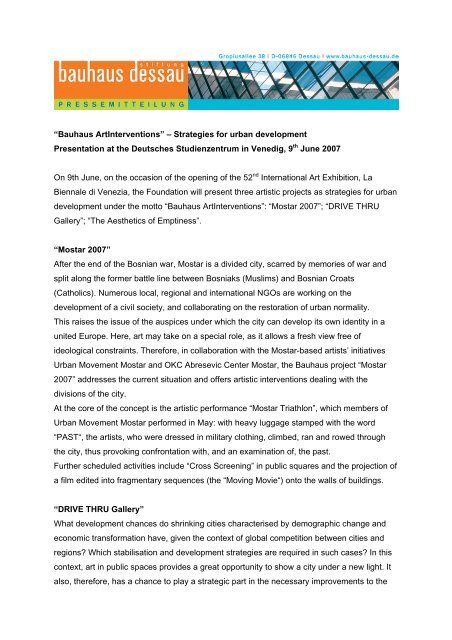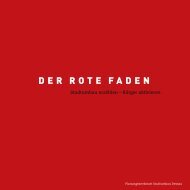press release - bauhaus dessau - Bauhaus Dessau Foundation
press release - bauhaus dessau - Bauhaus Dessau Foundation
press release - bauhaus dessau - Bauhaus Dessau Foundation
You also want an ePaper? Increase the reach of your titles
YUMPU automatically turns print PDFs into web optimized ePapers that Google loves.
“<strong>Bauhaus</strong> ArtInterventions” – Strategies for urban development<br />
Presentation at the Deutsches Studienzentrum in Venedig, 9 th June 2007<br />
On 9th June, on the occasion of the opening of the 52 nd International Art Exhibition, La<br />
Biennale di Venezia, the <strong>Foundation</strong> will present three artistic projects as strategies for urban<br />
development under the motto “<strong>Bauhaus</strong> ArtInterventions”: “Mostar 2007”; “DRIVE THRU<br />
Gallery”; “The Aesthetics of Emptiness”.<br />
“Mostar 2007”<br />
After the end of the Bosnian war, Mostar is a divided city, scarred by memories of war and<br />
split along the former battle line between Bosniaks (Muslims) and Bosnian Croats<br />
(Catholics). Numerous local, regional and international NGOs are working on the<br />
development of a civil society, and collaborating on the restoration of urban normality.<br />
This raises the issue of the auspices under which the city can develop its own identity in a<br />
united Europe. Here, art may take on a special role, as it allows a fresh view free of<br />
ideological constraints. Therefore, in collaboration with the Mostar-based artists’ initiatives<br />
Urban Movement Mostar and OKC Abresevic Center Mostar, the <strong>Bauhaus</strong> project “Mostar<br />
2007” addresses the current situation and offers artistic interventions dealing with the<br />
divisions of the city.<br />
At the core of the concept is the artistic performance “Mostar Triathlon”, which members of<br />
Urban Movement Mostar performed in May: with heavy luggage stamped with the word<br />
“PAST“, the artists, who were dressed in military clothing, climbed, ran and rowed through<br />
the city, thus provoking confrontation with, and an examination of, the past.<br />
Further scheduled activities include “Cross Screening” in public squares and the projection of<br />
a film edited into fragmentary sequences (the “Moving Movie“) onto the walls of buildings.<br />
“DRIVE THRU Gallery”<br />
What development chances do shrinking cities characterised by demographic change and<br />
economic transformation have, given the context of global competition between cities and<br />
regions? Which stabilisation and development strategies are required in such cases? In this<br />
context, art in public spaces provides a great opportunity to show a city under a new light. It<br />
also, therefore, has a chance to play a strategic part in the necessary improvements to the
profile of a city. In Aschersleben, a small city in Saxony-Anhalt, such an attempt is currently<br />
underway. The site is an essentially inhospitable inner city ring marked by noise and dirt. The<br />
housing in the most affected areas is already disused. Historic structures are disintegrating.<br />
A dynamic, rapidly changing space is coming into being.<br />
In this transformation phase, the structural re-coding of the space is achieved by art works<br />
placed alongside the road through the town: the DRIVE THRU Gallery project. This liberates<br />
“public art” from its decorative role and the gallery becomes a space – an exceptional artistic<br />
space – in itself.<br />
The DRIVE THRU Gallery is the first of its kind in Germany. With in excess of 10,000<br />
vehicles per day, the through road has a huge number of visitors. The DRIVE THRU Gallery<br />
aims to make the motorist, while “passing through”, the audience of an artistic space.<br />
A number of different exhibition formats are adapted to the existing building substance. The<br />
aim is to use these as “repairs” to the shrinking city. As such, the windows of empty houses<br />
are used to exhibit art, and are thereby secured and re-valued. Gaps between buildings are<br />
enhanced, and therefore filled, with images or three-dimensional objects. The DRIVE THRU<br />
Gallery is an additive system, which will grow and remain flexible from 2007 to 2010. A first<br />
large-scale art action will see the installation of five large-format prints of paintings by the<br />
British artist Christopher Winter. The originals of his works will be shown simultaneously in<br />
the Neuhoff Gallery in New York.<br />
The DRIVE THRU Gallery project is part of the International Building Exhibition IBA Urban<br />
Redevelopment 2010 Saxony-Anhalt. Curator is the <strong>Bauhaus</strong> <strong>Dessau</strong> <strong>Foundation</strong>. The<br />
project DRIVE THRU is supported by the city of Aschersleben and sponsored by the<br />
Kunststiftung Sachsen-Anhalt.<br />
“The Aesthetics of Emptiness”<br />
Emptiness in the urban context is not a clear-cut situation. Empty spaces may be seen as<br />
signs of generosity or of wastefulness and decline. Emptiness is also governed by other<br />
factors: by its history, its atmosphere and the presence, or absence, of public life.<br />
The project in Halberstadt, a city in Saxony-Anhalt, examines the emptiness caused by<br />
shrinkage processes, whereby the fundamental issue is the aesthetics of emptiness. In the<br />
destruction of the 2 nd World War, Halberstadt lost its medieval centre. The city is now<br />
characterised by empty spaces and wide axes. A dwindling population also contributes to the<br />
fact that large sections of urban emptiness have been unused for some time. Here,<br />
emptiness can be a quality if the public accepts its interpretation and design as a challenge.<br />
Under the creative guidance of Detlef Weitz (chezweitz&roseapple, Berlin), individual sites<br />
will be connected by a footpath through Halberstadt, which will provide experiences of the
different aspects of emptiness. Artistic strategies, rather than artworks, will be put to<br />
processual use on this “Vision-training pathway” – so that the urban spaces seen as “empty”<br />
– are reintegrated into the public debate.<br />
The basic idea is to free the empty spaces from everyday patterns of perception with the aid<br />
of simple, but unusually arranged, objects and marking elements. Through this productive<br />
irritation of the viewer, the sites are removed from their original context and lent the air of an<br />
exhibit. In doing so, the public are presented with visual tools, which allow those interested to<br />
experience the emptiness on-site. Visual bridges that bring scarcely visible spatial<br />
relationships into view are erected and again demolished. In Halberstadt, the visualisation of<br />
emptiness will be trained, and its revitalisation debated, in a continuous process.<br />
The project is part of the International Building Exhibition IBA Urban Redevelopment 2010<br />
Saxony-Anhalt. Curator is the <strong>Bauhaus</strong> <strong>Dessau</strong> <strong>Foundation</strong>. Concept and realisation of<br />
“Vision-training pathway” and the exhibition “The Aesthetics of Emptiness”: Detlef Weitz,<br />
scenographer, chezweitz & roseapple, Dr. Martin Peschken, literature scholar<br />
The event will be held in English.<br />
Programme<br />
5 p.m.<br />
Welcome<br />
Dr. Uwe Israel<br />
Director of the Deutsches Studienzentrum in Venedig<br />
Introduction<br />
Prof. Dr. Omar Akbar<br />
Director of the <strong>Bauhaus</strong> <strong>Dessau</strong> <strong>Foundation</strong><br />
Project Presentations<br />
Wilfried Hackenbroich, Architect, Berlin; Kai Vöckler, Artist, Berlin; Dr. Sonja Beeck,<br />
Architect, <strong>Bauhaus</strong> <strong>Dessau</strong> <strong>Foundation</strong><br />
Commentary<br />
Ute Meta Bauer, Director and Associate Professor, MIT Visual Arts Program, Massachusetts<br />
Institute of Technology, Cambridge; Okwui Enwezor, Dean of Academic Affairs and Senior<br />
Vice President, San Francisco Art Institute
Venue:<br />
Deutsches Studienzentrum in Venedig<br />
S. Polo 2765/a<br />
30125 Venedig<br />
Date:<br />
9 th June 2007, Begin 5 p.m.<br />
Pressereferentin:<br />
Dr. Annette Zehnter<br />
Stiftung <strong>Bauhaus</strong> <strong>Dessau</strong><br />
Gropiusallee 38<br />
06846 <strong>Dessau</strong><br />
Tel. 0340 6508225<br />
Fax: 0340 6508226<br />
E-Mail: zehnter@<strong>bauhaus</strong>-<strong>dessau</strong>.de<br />
www.<strong>bauhaus</strong>-<strong>dessau</strong>.de



